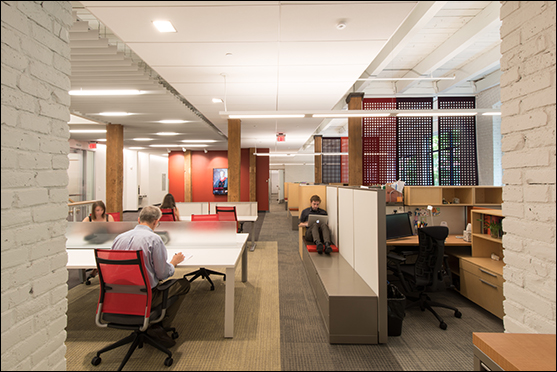
UUA's new HQ gets top green building designation
24 Farnsworth Street office building awarded LEED platinum certification.
From energy-efficient computers to green cleaning products, hundreds of choices were made to create as environmentally conscious and healthy a space as possible, said Rob Molla, the UUA’s director of Human Resources, who led the design team.
In early December, the UUA’s new headquarters at 24 Farnsworth Street was awarded Leadership in Energy and Environmental Design (LEED) platinum certification, the highest of four levels awarded by the U.S. Green Building Council (USGBC). Only 5 percent of the approximately 75,000 buildings in the U.S. that have LEED certification have achieved platinum status, according to the USGBC.
24 Farnsworth Street uses 40 percent less energy in lighting than comparable buildings and 35 percent less water. About 75 percent of the construction debris from renovating the space, or 91 tons, was diverted from landfill. More than one-third of the construction materials had recycled content, and 38 percent were regionally sourced within 500 miles of Boston, according to Zsuzsanna Gaspar, project architect and principal at Goody Clancy, the architectural firm for the project.
“Having worked in LEED and on green building projects for almost 20 years, I can tell you that the fact the UUA achieved platinum is a very big deal,” said Summer Minchew, the LEED expert at Ecoimpact Consulting in Washington, D.C., who guided the project through the certification process. “It is not easy, and the USGBC keeps raising the bar to make it harder and harder.”
The building also earned “exemplary performance” in two areas: use of regional materials and promotion of alternative transportation to encourage employees not to drive to work. The building is a short walk from the subway, offers no free parking for employees, and has bicycle racks.
“We knew going into this that we’d aim for LEED certification,” said Molla. “Not only would it be part of our UU values and help us live into the Seventh Principle in a real way, but it would be good for the staff and visitors who come to the UUA headquarters.”
Some green decisions weren’t as cheap as the alternatives. It cost around $30,000 to upgrade toilets and sinks in the bathrooms to make them more efficient and save water, Molla said. The carpet cost $18,000 more than budgeted but will last for many years, is recyclable, is more accessible for wheelchairs, and has low volatile organic compound off-gassing. “It hit everything we wanted to do, so we made a decision to spend a little more on that,” Molla said.
“It was more expensive to certify platinum,” Molla said, “but we know those costs, over the long run, will come back to us in savings in the health of our staff and visitors, and savings to the environment and in reduced carbon emissions. That will more than make up for those initial costs.”
The design, renovation, and furnishing of the three-story space cost the UUA approximately $10 million, according to Tim Brennan, treasurer and chief financial officer.
Molla credited the UUA’s design team for achieving platinum status: Helene Atwan, director of Beacon Press; Tom Hallock, associate publisher at Beacon Press; the Rev. Sarah Lammert, director of Ministries and Faith Development; Taquiena Boston, director of Multicultural Growth and Witness; Stacey Dixon, General Assembly and Conference Services administrator; and Katrina Foster, Stewardship director. The Rev. Harlan Limpert, chief operating officer, Tim Brennan, treasurer and chief financial officer, and Michael O’Herron, director of Operations also played a huge role, he said, as did Mark Steinwinter, director of Information Technology Services, and Larry Stritof, systems analyst.
“UUs hold us to incredibly high standards and we didn’t want to let people down,” said Molla. “We wanted to carry the banner of green as an example, and to say, ‘If we can do it, our congregations can, other organizations, other nonprofits can.’ It was important for us to be a model.”
Photograph (above): Workspaces at 24 Farnsworth Street (© Ganesh Ramachandran/Goody Clancy). See sidebar for links to related resources.
Comments powered by Disqus






